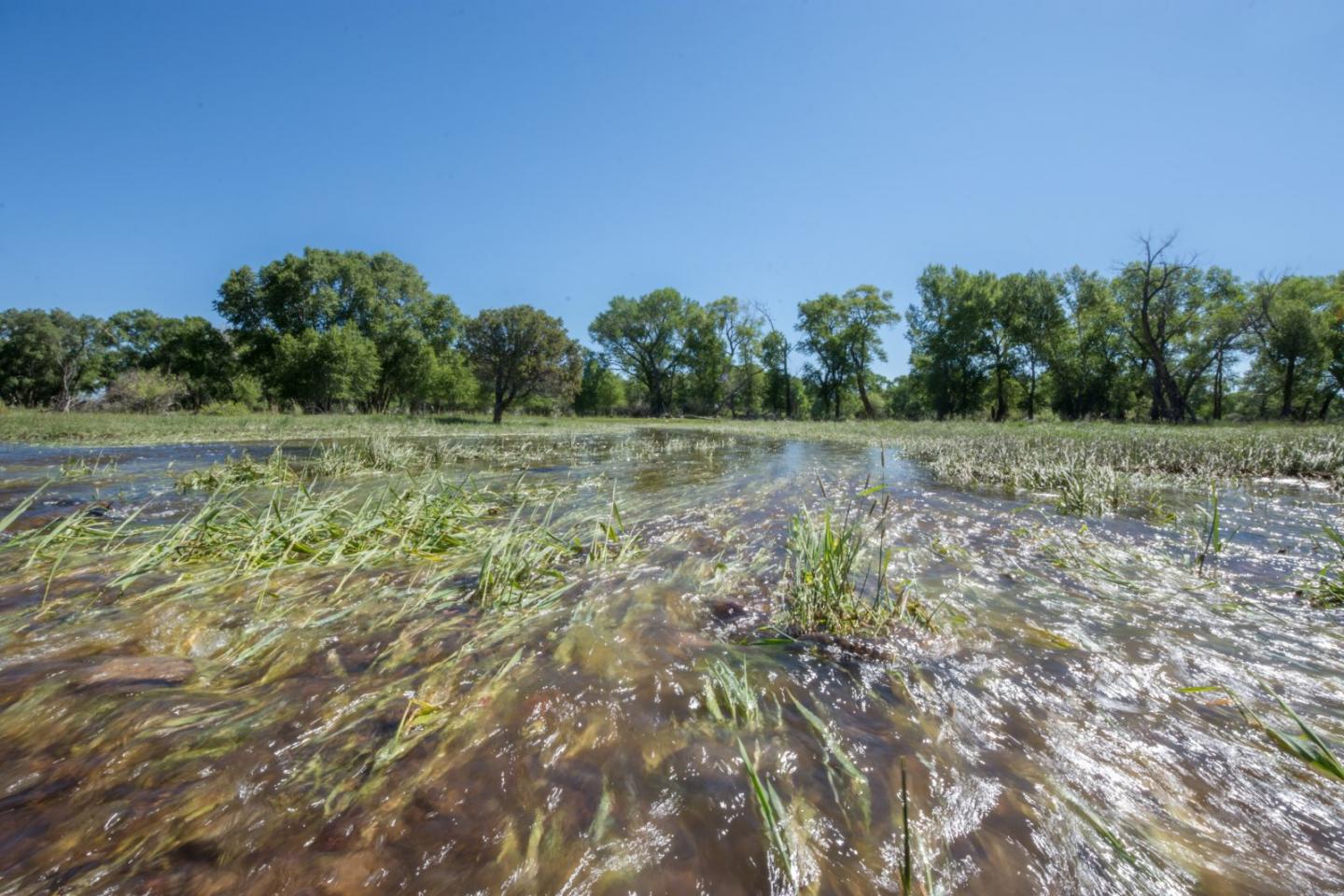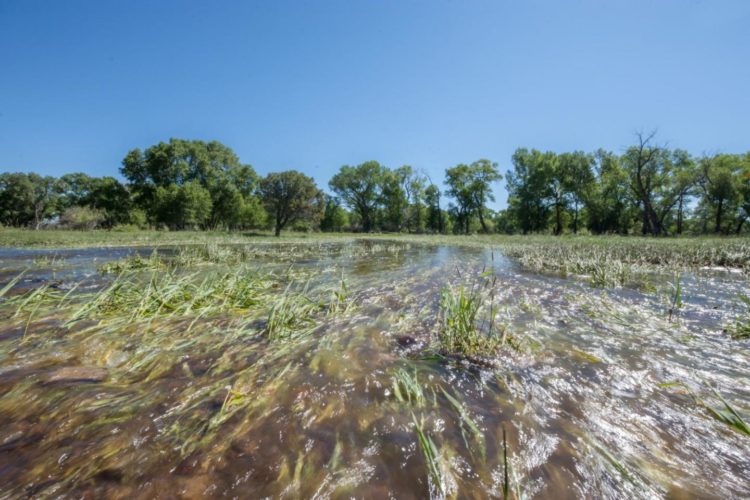
Credit: Virginia Tech
Wetlands in the Intermountain West, a region nestled between the Rocky Mountains, the Cascade Range, and the Sierra Nevada, are home to a diverse range of flora and fauna. Wetlands may only make up two percent of the region, but 80 percent of wildlife rely on the rich habitat they provide. The majority of these wetlands are located on private ranchlands. While the persistence of these “working wetlands” depends on the management decisions of ranchers, their perspectives are often missing from conservation and policy-making discussions.
In a new study published in Rangeland Ecology and Management, Ashley Dayer, an assistant professor in the Department of Fish and Wildlife Conservation in the College of Natural Resources and Environment at Virginia Tech, explores the diverse factors that influence how ranchers manage their land.
In collaboration with the Intermountain West Joint Venture, an organization committed to bird habitat conservation by fostering public-private partnerships, and the University of Montana, Dayer and her graduate student Mary Sketch (M.S. ’18) hosted two landowner-listening workshops, one in southern Oregon and another in southwestern Wyoming, and invited various landowners and conservation professionals to encourage dialogue between the two parties. Partners for Conservation, a landowner-led conservation organization, played a key role in successful implementation of the workshops.
“In order to have effective conservation in the west, where ranchers own huge tracts of land, the conservation community is keen to work together with them. Ranchers can make choices to manage their land for the benefits of wildlife or they can make choices that don’t prioritize wildlife,” said Dayer, an affiliated faculty member of the Global Change Center, housed within the Fralin Life Sciences Institute. “We aimed to facilitate a better understanding of how conservation professionals could work with ranchers toward conservation and wildlife management goals.”
The relationships between conservationists and ranchers can be complicated. People are quick to assume that ranchers are solely concerned with profit, but Virginia Tech researchers find that ranchers’ decisions are more complex than that. This complexity needs to be taken into consideration when developing programs and policies to foster private lands conservation.
“The workshops created an open, trusting space where there was social learning and social exchange happening. It was important for ranchers to know the researchers and the conservation professionals alike were there to hear them,” said Mary Sketch, who was the lead author on this paper and another previously published in Society and Natural Resources on the method itself.
Dayer and Sketch evaluated the complex decision-making process of how ranchers choose to manage their land, more specifically how they choose to irrigate their land and why. They found that various reasons go into deciding how land is managed — not just money.
“Our project was able to add nuance to that understanding; there is a lot more to it,” said co-author Alex Metcalf, a social scientist and assistant professor in the W.A. Franke College of Forestry and Conservation at the University of Montana. “Yes, ranchers have to meet the bottom line because they have to make sure they have food on the table, but other concerns and considerations are at play in the choices that they make for their lands.”
This study specifically focused on choices about flood irrigation — a traditional method involving complex ditch systems that spread water across a field, recharging areas once sustained by natural flooding. When the water flows from the ditches, saturates the field, and seeps into the groundwater, it provides forage for cattle to graze on while providing rich habitat for migrating and breeding waterbirds, like ducks and cranes, as well as sage-grouse, an iconic ground-dwelling bird in decline.
“Flood irrigation is often vilified for not being water efficient. The numbers don’t always add up when it comes to saving water because there’s so much more in the game of land management and conservation, like creating wildlife habitat. This traditional definition of efficiency doesn’t grasp that social-ecological complexity,” Sketch said. “Our work suggests an expanded definition that considers how flood irrigation provides bird habitat on working wet meadows, recharges the groundwater for communities downstream, creates in-stream flow for fish, and keeps ranchers ranching.”
Ranchers described the factors that either help or hinder the use of flood irrigation on private lands. The study identified cultural considerations as a key enabler for continuing flood irrigation. “Ranchers have strong ties with the ranching lifestyle, so many choose to continue flood irrigation because of its history and their personal connection to it,” explained Sketch. “It’s something they do every year, the generation of ranchers before them did it, and want to maintain that tradition.”
“What stands out to me in this work is that there are a group of ranchers committed to the future of their land. They rely on that land for their livelihood; they’re closely tied to it; they spend every day outside. It’s something that they’re very passionate about,” Dayer said. “I think that’s just a critical thing for the majority of the U.S. public living far from ranches to keep in mind — our food isn’t just coming from grocery stores. It’s coming from people who are making choices about how land is used and whether to contribute to conservation.”
Despite the commitment of ranchers to their land, nearly half of all U.S. ranches are sold every decade and recruitment of younger generations into the ranching lifestyle has declined. Most of these once-open spaces have been lost to subdivisions and other development. Land conversion not only erodes the sense of community and cultural identity among ranchers, it also eliminates important wildlife habitat.
To keep ranches both environmentally and economically sustainable, both workshops highlighted key areas where conservation professionals can increase rancher engagement and ensure working wetlands continue to benefit both landowners and wildlife. Ranchers identified partnerships and open communications with conservation professionals and policymakers as critical to maintaining successful operations in addition to effective, long-lasting conservation practices. Central to strong partnerships is building trust and “honest people sitting around, getting over their biases, their agendas, and listening to one another,” said one rancher.
The Intermountain West Joint Venture has a long history of working alongside landowners and conservationists and has become trusted in the region. Their connections, experiences, and on-the-ground work proved valuable in executing the research. As a result, Dayer and Sketch were better able to understand ranchers’ experiences and perspectives. The joint venture is also now playing a critical role in ensuring the results of this study are used.
“This research is ground-breaking in that it helps conservation professionals understand the social context of agricultural irrigation decision-making in the West,” said Dave Smith, Intermountain West Joint Venture coordinator. “The findings will enable the conservation community to increasingly support agricultural irrigators in continuing to provide vital habitat for wetland-dependent birds on working lands.”
Listening turned out to be an effective conservation tool, and Dayer and Sketch hope that this work continues to change how conservation professionals and ranchers work together.
###
Media Contact
Kristin Rose
[email protected]
540-231-6614
Original Source
https:/
Related Journal Article
http://dx.





